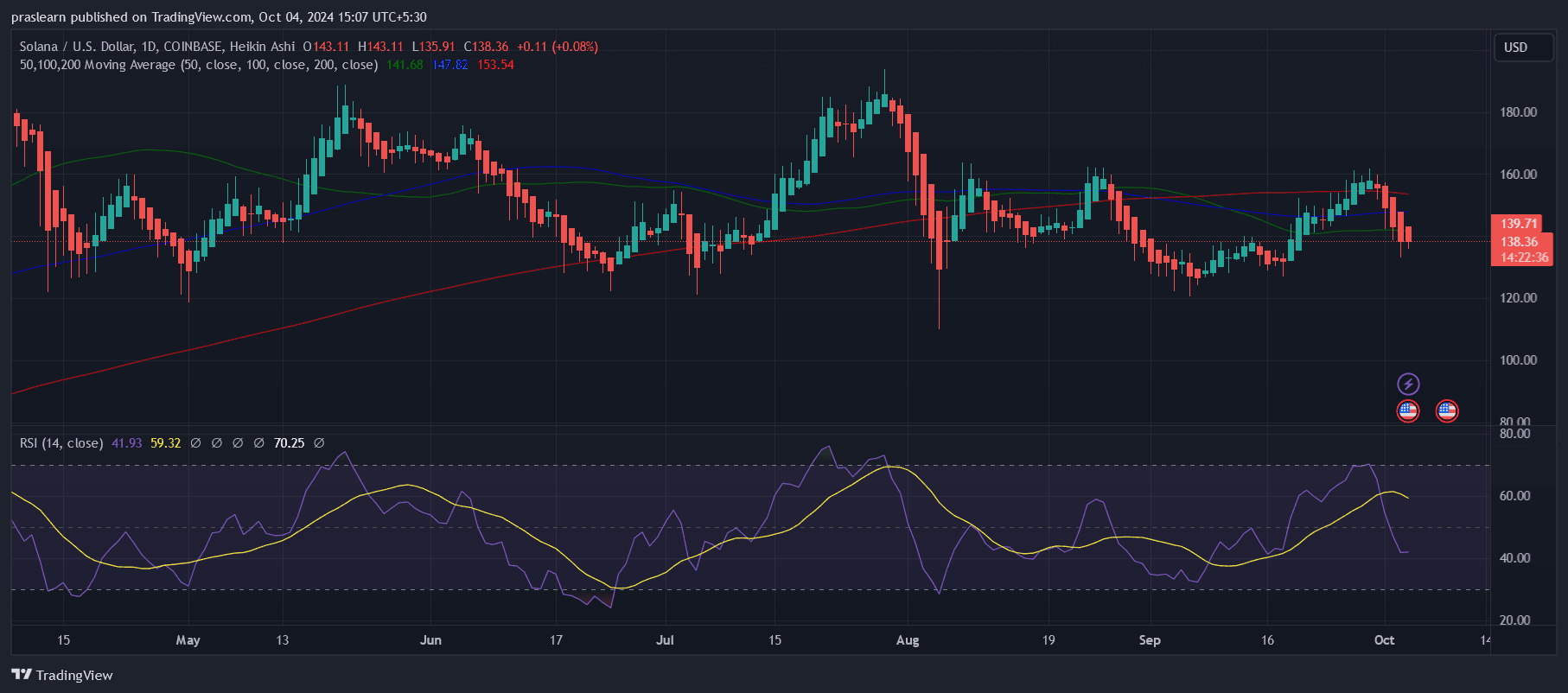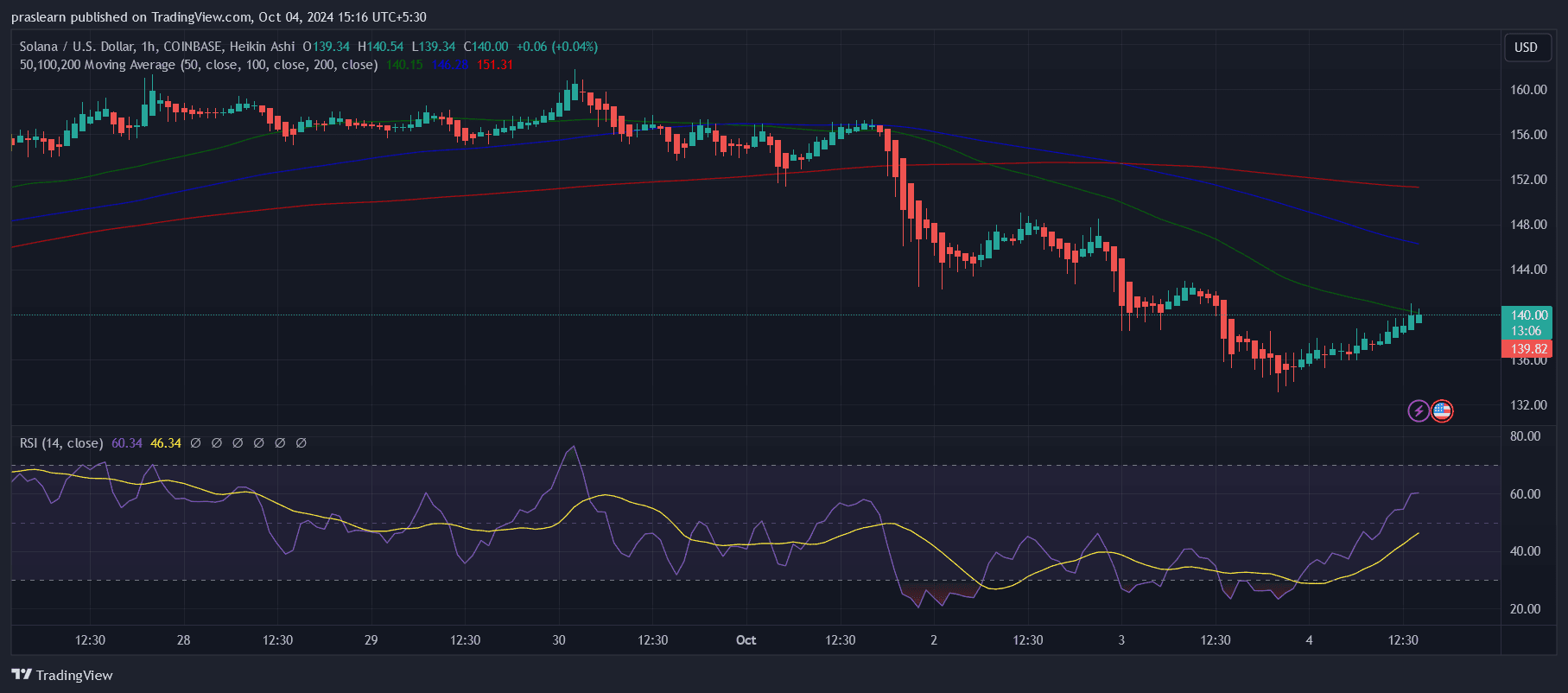October has started off rough for Solana, with its price dropping over 14%. While the cryptocurrency market is always full of surprises, Solana's decline is largely due to a mix of global uncertainties and some technical concerns within its own network. This has left investors wondering: Is this just a bump in the road, or is Solana facing a bigger issue that could impact its value for the rest of the month? In this Solana Price Prediction article, we'll explore the key factors driving Solana’s recent price movement and what to watch for in the coming weeks—will it make a comeback or continue to struggle?
How has the Solana Price Moved Recently?

As of today, Solana is priced at $140.03, with a 24-hour trading volume of $12.28 billion, a market cap of $65.67 billion, and a market dominance of 3.06%. Over the last 24 hours, SOL's price has risen by 1.98%.
Solana hit its peak on November 6, 2021, reaching an all-time high of $259.52. Its all-time low was recorded on May 11, 2020, when it traded at just $0.503701. Since then, the lowest price following its all-time high was $8.12 (cycle low), while the highest point it reached since that low was $208.75 (cycle high). Currently, the sentiment around Solana's price forecast appears bearish, and the Fear & Greed Index stands at 41, indicating a state of fear in the market.
Solana's circulating supply is 468.98 million SOL, with a maximum supply of 533.68 million SOL. The yearly supply inflation rate is currently 13.43%, with an additional 55.54 million SOL minted over the past year.
Will Solana (SOL) Price Drop Further?

Solana (SOL) has been performing well within the decentralized finance (DeFi) landscape, maintaining strong momentum in market share and transaction volume. As indicated by DeFi Llama, Solana's ecosystem has experienced a weekly volume increase of 46%, reaching $9.25 billion. This positions Solana as a strong contender right behind Ethereum, the leader in the DeFi space. A significant portion of this growth stems from Raydium, which has seen a 71% surge in volume to $4.3 billion.
Other platforms in the Solana ecosystem, like Orca, Phoenix, and Lifinity, are also contributing substantially to the network's transaction volume, indicating healthy growth and activity. Moreover, the total value locked (TVL) within Solana has risen to over $5.06 billion, marking its highest point since 2022. With six major networks reaching a combined TVL of over $1 billion, Solana’s DeFi ecosystem is proving robust and thriving.
Despite this strong performance, Solana's price movement is currently influenced by macroeconomic factors and geopolitical events rather than its on-chain metrics. The ongoing sell-off is largely a reaction to the escalating geopolitical tensions, notably the news about Israel considering military action against Iran.
Such a conflict could lead to heightened global uncertainty and inflationary pressures, potentially slowing down any anticipated interest rate cuts by central banks. This scenario can result in market instability, adversely affecting the broader cryptocurrency market, including Solana.
In light of these factors, Solana's near-term price could face further downward pressure. While the ecosystem fundamentals are strong, external geopolitical risks and market sentiment play a significant role in price movements. If tensions continue to escalate, there may be further sell-offs across the crypto market, impacting SOL.
However, the growing DeFi activity and rising TVL within the Solana network are positive indicators that could drive a price recovery once the macroeconomic conditions stabilize. Ultimately, whether Solana's price will drop further depends on how geopolitical tensions unfold and the market's response to potential economic shifts, such as changes in interest rate policies. If global risks subside, Solana's strong DeFi ecosystem could support a rebound, but if the uncertainties persist, further price drops are possible.
Solana Price Prediction: Bull or Bear in October?
Solana has demonstrated a remarkable performance over the last year, with its price surging by an impressive 510%. This growth has outpaced 92% of the top 100 crypto assets, positioning Solana as a standout performer in the broader crypto market. Even when compared to the industry giants like Bitcoin and Ethereum, Solana has exhibited superior returns, underlining its appeal as a high-growth asset within the space.
Furthermore, the token has had a strong track record in recent months, with 16 green days in the last 30, suggesting consistent bullish sentiment despite current market fluctuations. This stability, coupled with Solana's high liquidity relative to its market cap, provides a buffer against drastic volatility and makes it a more reliable asset for investors.
However, Solana is currently trading below its 200-day simple moving average (SMA), typically a bearish indicator signaling that the asset may face continued downward pressure in the near term.
The yearly inflation rate of 13.43% is another factor to consider, as it implies a relatively high rate of new token issuance, which can put pressure on the price if demand doesn't keep pace with supply. Yet, the strong fundamentals of Solana's DeFi ecosystem and its ability to handle large transaction volumes—second only to Ethereum—point to underlying strength and potential for long-term growth.
Given these mixed indicators, the price direction for Solana in October is balanced between bullish and bearish factors. On the bullish side, Solana’s impressive 1-year growth and outperformance of top crypto assets demonstrate its strong market position.
The increased weekly volume in its DeFi ecosystem and the rise in total value locked (TVL) reinforce its fundamental strength. If the market focuses on these fundamentals and the geopolitical situation stabilizes, Solana could see a positive rebound in October, driven by renewed investor confidence and the network’s growing utility.
Conversely, the bearish pressures stem from external macroeconomic factors like global geopolitical tensions and inflation concerns, which have already led to a recent sell-off.
Additionally, trading below the 200-day SMA may lead to cautious investor behavior and potential downward movement. Should the geopolitical risks intensify or inflation fears deepen, it could hinder Solana’s ability to rally in the short term.
Overall, while Solana's long-term growth prospects remain strong, October’s outlook appears mixed. It could be a month of consolidation, with short-term bearish tendencies counterbalanced by the token's strong fundamentals and potential for recovery if external conditions improve.
Therefore, Solana’s performance in October will likely depend on how these factors play out, potentially leading to either a cautious bull or continued bear trend for the month.
 cryptoticker.io
cryptoticker.io